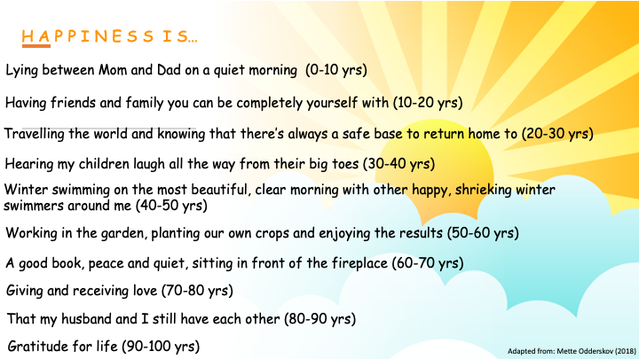Happiness
Lessons From One of the Happiest Countries in the World
The house of Danish happiness.
Posted October 22, 2020 Reviewed by Kaja Perina
Once upon a time, in a Nordic land of famous fairy tales, on a quiet street with white houses and cobbled sidewalks, a small museum opened its doors. The museum had eight different rooms, all dedicated to unlocking the mystery and history of the most cherished of human emotions — happiness.
It was a strange time for The Happiness Museum to be born. Humans had made it halfway through 2020. The planet was busy tending to its wounds. Governments kept announcing new rules. Smiles were rare, frowns were everywhere. Uncertainty loomed. Hugs were still forbidden. And yet, the museum’s arrival was a reminder for humans not to lose sight of the wonders big and small that made their hearts sing with joy.
Meik Wiking is a happiness expert from Denmark, where it rains on average 170 days a year. He is the CEO of the Copenhagen-based Happiness Research Institute (the think tank behind The Happiness Museum) and the author of internationally bestselling books on the Danish way of happiness. One of the biggest insights he has gained from researching happiness while living in the second happiest country in the world is that no matter where people are from, there are a number of common things that tend to make them happy. These universally cherished happiness drivers are:
- Having a sense of purpose in life
- Finding meaning in work
- Good relationships
- Sound health
But are there also uniquely culture-specific routes to happiness? For example, what does happiness in Denmark look like?
Danish author Mette Odderskov explored this question by asking 500 Danes of different ages to complete the sentence “Happiness is…” The results of her survey revealed a poignant, if not surprising picture.
While some of the answers were indeed shaped by Danish traditions (“summer hiking in Norway,” “winter swimming,” “enjoying a herring sandwich and schnapps with friends”), the most prevalent themes of happiness revolved around nature, family, and love. In fact, Odderskov’s research highlights what has long been established by science (and friends and lovers everywhere): Warm and enduring bonds with our fellow humans have astounding benefits for our wellbeing.
“While happiness is incredibly beautiful to experience,” Odderskov writes, “it is even more beautiful to share.”

What if, in honor of the host country of The Happiness Museum, we could conceptualize Danish happiness — with all its familiarity and distinctiveness — as a house? What might be some of the main concepts that would hold The House of Danish Happiness together?
Meik Wiking suggests five defining aspects that would go into the construction: taxes (foundation), converting wealth into wellbeing (infrastructure, ground floor), work-life balance (walls), trust (second floor), and Hygge (a small, cozy room upstairs).
Here is Wiking in his own words.
Taxes: In Nordic countries, we pay some of the highest taxes in the world. Yet, 88% of people living in Denmark are happily paying their taxes. We often say that we are happy not despite the high taxes, but because of them. The taxes we pay enable us to enjoy a high quality of life and feel supported. For example, in Denmark, healthcare is free. Elderly care is free. University education is free. Children’s day-care is heavily subsidized and schooling for children with special needs is also free. Every Danish citizen is entitled to economic support if they are unemployed. By paying our taxes, we are investing in quality of life, which is ultimately more important than individual wealth.
Converting wealth into wellbeing: Denmark is not the richest country in the world. However, we successfully convert our wealth into wellbeing by investing in the common infrastructure. This enables Danes to thrive socially, physically, and mentally. It is not about how much wealth we accumulate, but what we do with the wealth we have.
Work-life balance: The Nordic countries have some of the best balance between work and family life. We enjoy short workdays, paid vacation, subsidized childcare, maternity, and paternity leave. This allows us time at the end of the day for some Hygge.
Trust: The Nordic countries enjoy high levels of trust. According to research, people who trust their neighbours, their government, or their public services are on average happier than those who don’t have trust. In Denmark, it’s not uncommon to see parents safely leaving their babies in prams outside restaurants and shops for a short while as they run errands.
Hygge: As a fundamental aspect of Danish culture, Hygge encompasses being together with our loved ones, feeling safe and comfortable, letting our guard down. It doesn’t require any material thing. Instead, it’s a feeling, an atmosphere, an experience. It is about making the most of each day, by allowing ourselves time to enjoy the simple pleasures in life. In a way, Hygge can become an important driver for everyday happiness.

We can learn a lot from exploring happiness around the world — about others, about ourselves, about the “magic things,” as the poets say, “that are patiently waiting for our senses to grow sharper.” It’s heartening to know that no matter which oceans and hills surround us, which seasons and fates befall us, humans will never run out of ways to mill joy from their finite, fleeting hours. Sometimes, alone. Often, together.
Many thanks to Meik Wiking, Marianne Pryning, and Mette Odderskov for their time and insights. Meik Wiking is the author of The Little Book of Hygge (2016), The Little Book of Lykke (2017), and The Art of Making Memories (2019). Marianne Pryning is the illustrator of the Danish House of Happiness. Mette Odderskov is the author of Happiness Is (2018).
Facebook image: Syda Productions/Shutterstock




